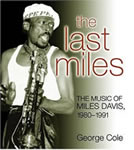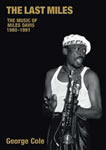In 1984, Annabel Jankel and her partner Rocky Morton directed Miles’s first music video, “Decoy.” The video, shot in black-and-white, combined film with computer graphics and animation, a technique pioneered by Jankel and Morton in the pre-MTV days and which subsequently influenced many music video directors.
You can watch the Decoy video on YouTube.
For the shoot, Miles was placed on a turntable with a Hot-Head camera (which can pan 360-degrees) whizzing around him. Jankel and Morton got Miles to mime and spin his arms around to create streams of coloured graphics (which were added in post-production). Guitarist John Scofield also appears, although you only see his hand on the guitar fingerboard. Today, more than 20 years after it was shot, the “Decoy” video still looks fresh. I interviewed Annabel for The Last Miles, but during a whistle-stop trip to London (Annabel now lives in LA), we met and I got to ask her a little more about the making of the “Decoy” video.
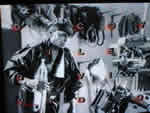
|
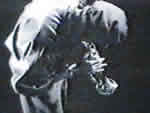
|
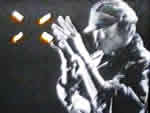
|
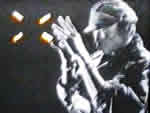
|
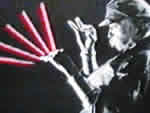
|
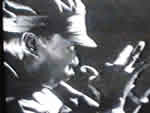
|
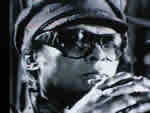
|
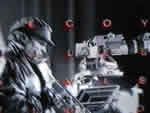
|
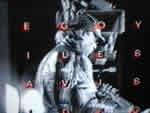
|
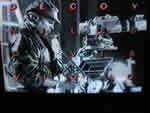
|
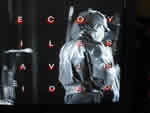
|

|
GC: Were you a Miles fan before you got the video commission?
AJ: Rocky and I used to be punks, but like many people we had one or two of the important Miles Davis albums, things like Kind of Blue.
GC: Why did you and Rocky get the commission?
AJ: I’m not really certain, but I think they [Columbia Records] realised that they needed to drag Miles into a new audience and it seemed possibly the way to do it was by combining animation, graphics, whatever. So we got the call and of course, we were very excited about that. Our first reaction was ‘THE Miles Davis? This wasn’t some MiIes Davis from Neasden High Street [in London]?!’ We thought Miles was just way too iconic and we didn’t even know that he was still alive.
GC: Describe your first meeting with Miles
AJ: Obviously Miles had to sign us off [approve] and we went to a meeting with him at Columbia Records in this great big board room with a huge table. He came in and he was very, very angry, but I only came to realise later that it was really a front. He had this very elaborate walking stick and he proceeded to start strangling it and at the same time there was this terrible diatribe against everybody – whites, blacks, Jews, non-Jews. He was very bummed because he would drive his Ferrari around and being black, it wouldn’t go down too well with the white policemen and so he’d be pulled over. I remember him complaining about that.
GC: Your concept for the video and Miles’s concept were very different!
AJ: He was very enthusiastic about doing something that involved dancing girls! A sort of can-can in the desert. The piece of music was really a beautiful piece of music and I didn’t want to have something flash, like a whole bunch of Playboy Bunnies prancing around the desert. I would have been forever mortified if I’d had something to do with it. So we set about convincing him. “Miles, that’s a fabulous idea, but there’s a certain expectation, an iconic status that you have. There’s all the gravitas that comes with the name Miles Davis.’
GC: How did he take it?
AJ: It took a little bit of persuasion! I think he tried to hang on to his idea for quite a while, but eventually he became convinced that it wasn’t a good idea. I think he liked the idea of the experience of being in the desert with the dancing girls rather than the end result!
GC: Did you have a concept for the video when you met Miles?
AJ: I’ve got a feeling that we did – I can’t exactly recall. There wasn’t a second meeting, so I’m pretty sure we would have pitched it when we first met Miles. Obviously it went down well at the time, so it was news to me when I read the passage in your book that he didn’t really like the video. He never really commented on it to tell you the truth. We never had any further contact with him and there was no reason to. We shot, edited it, we did the animation, put it all together and the record company was very happy. And then we moved on to the next project.
GC: Where was it shot?
AJ: In New York. We hired a small stage and we had managed to work the budget to hire an expensive, brand-new piece of equipment, the Hot-Head. It gave us the latitude to allow Miles to play with his back to the camera, which was his signature thing. He didn’t really want the camera down his neck. We could explore him as if he was the instrument.
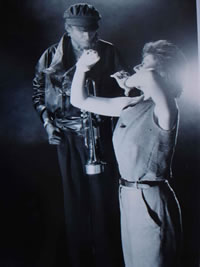
Annabel Jankel directing Miles during the shooting of the “Decoy” video.
Photo courtesy of Peter Shelton and Annabel Jankel. © Peter Shelton
GC: You went to Miles’s place to look at his clothes and trumpet for the shoot?
AJ: We got invited to visit the great Miles Davis in his home environment and we felt very privileged. It was a huge apartment but strangely claustrophobic, because there was grey carpet, on the floor, up the wall and maybe even on the ceiling. Maybe it was some sort of sound-proofing. He was wonderful and Cicely Tyson answered the door and she was incredibly gracious and glamorous – diva-like. Miles was dressed casually. I remember him having loads of leather jackets and throwing them all over the bed for us to look at. We chose one and he was very happy with it.
GC: But getting the right trumpet wasn’t so easy!
AJ:We said “Okay Miles, which trumpet are you going to use?” And he pulls out this terrible bright, shocking pink, anodised trumpet! We hadn’t decided to shoot in black-and-white at this stage. So we say: ‘Miles, Miles Davis doesn’t play the pink trumpet, what else have you got? So he then pulls out a turquoise anodised trumpet and then he pulls out another one! It was like: “Miles where’s the trumpet that you play?’ and he said “This is what I play.” So we get to the shoot day and we ask him to bring a normal trumpet, but he doesn’t bring one. We were very confused, because we had Miles, but we didn’t have a trumpet. So we sent a PA [personal assistant] out to the local pawn shop and they managed to get a trumpet. But the trumpet was jammed up – it wouldn’t play at all, so all the time is ticking away and we’re thinking “We’re going to have to get another trumpet.”
“No, no, no,” says Miles, “I can fix this,” and so over the course of the two-day shoot, he made it his business to entirely take apart this clapped-out trumpet, clean it and fix it. He’d give various instructions to PAs to get this screwdriver and those cotton wool buds, this cleaning fluid and that. It was this huge surgical procedure and ultimately he restored the trumpet to working order during the downtime between takes. The end of the shoot came and it was like ‘what happens to the trumpet?’ The trumpet sort of demanded that it went back to the pawn shop. It had Miles’s magic infused into it and we loved the idea that we were going to put it back into the community and some unsuspecting soul was going to have the trumpet that Miles had personally put all his love and attention into. It seemed rather nice, that without knowing it, someone was going to get touched by the Miles magic.
GC: Tell us about the concept
AJ: It was one of those very naturalistic pieces of film making, even though it’s very stylised. It almost felt as if it pre-existed. Black-and-white Miles pre-existed, the way of shooting him pre-existed. I don’t recall there being a huge amount of agonising over the concept, although I know that Rocky and I story-boarded it out [GC note: sadly this has long since gone]. It became very clear to us that it had to be in black-and-white because we felt that was the world that Miles lived in. We had a full-time editor, Andy Gilman. We said to Andy that we wanted to deconstruct everything that we had shot and to treat the editing like Miles would treat his trumpet playing – to sort of free-form. Not to feel bound by any narrative or chronology but just edit from the gut and he did a wonderful job. He pieced it together and then we did the animation, which took two or three months.

Annabel Jankel in 2005
GC: Tell us about the shoot itself.
AJ: We didn’t have long involved takes. He wasn’t exactly delicate, but everyone knew he needed to be well looked after, so to exhaust him wasn’t tenable. I remember him drinking endless bottles of Perrier water – little bottles. So he certainly wasn’t on the booze or anything alternative. He was being really good and extremely cooperative after the initial resistance. He really didn’t get the miming, but it didn’t matter because he didn’t know what it was going to look like, though he knew he was going to be creating colours and effects. He was fantastic and wanted to do it until he got it right – he was a consummate professional.
GC: You also shot John Scofield playing the guitar, but we don’t see his face.
AJ: You couldn’t really, because it might have slightly taken away the sense of isolation. We wanted Miles to exist in his own world, a world where he was creating music and colour.
GC: We see Miles sitting at the beginning of the video and at the end, there’s a kind of symmetry.
AJ: It was also like a book with two covers and between them was the experience.
GC: You say there were two versions of it?
AJ: There was one which went through what at the time was a very modern pixellator processor. You used to turn a dial and it all suddenly went blocky, but in fact, I think the purer version with the animation not being fiddled around worked better.
